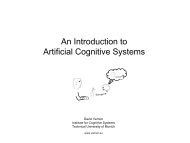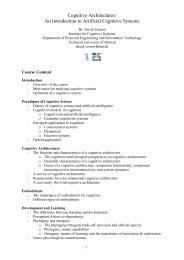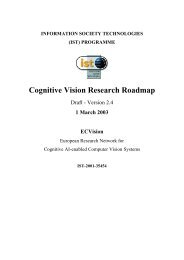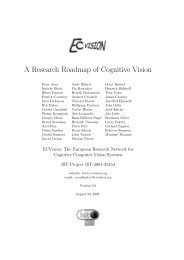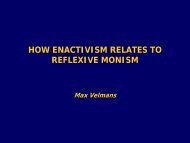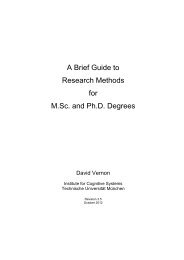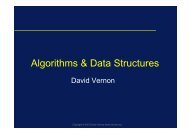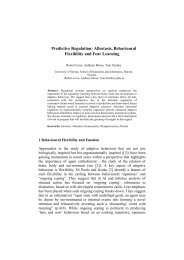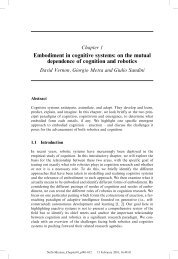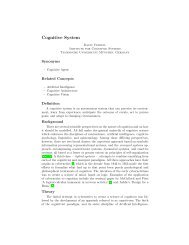Embodied embedded cognition and cognitive neuroscience
Embodied embedded cognition and cognitive neuroscience
Embodied embedded cognition and cognitive neuroscience
You also want an ePaper? Increase the reach of your titles
YUMPU automatically turns print PDFs into web optimized ePapers that Google loves.
A lazy brain?<strong>Embodied</strong> <strong>embedded</strong> <strong>cognition</strong><strong>and</strong> <strong>cognitive</strong> <strong>neuroscience</strong>Pim HaselagerIris van Rooij, Jelle van Dijk & Roel KerkhofsPhilosophyState University of São PauloMarília, BrazilArtificial Intelligence <strong>and</strong> CognitionNICI - Radboud UniversityNijmegen, The Netherl<strong>and</strong>swww.nici.ru.nl/~haselag
Questions• There appears to be a ‘slight tension’ between EEC<strong>and</strong> (<strong>cognitive</strong>) <strong>neuroscience</strong>• Whence ‘the opposition’?– The brain not as a conductor (Chiel & Beer, 1997) butrather a player in a jazz ensemble• More attention (funding) for body & environment = less forthe brain?• Implying that the brain is not ‘really’ important or just lazilycomping along?• Can there be such a thing as<strong>Embodied</strong> Embedded Cognitive Neuroscience?
Contents• Traditional <strong>cognitive</strong> <strong>neuroscience</strong>– Modularity, flowcharts & dissociation– Weakly EECy: the embodiment of meaning• Really EECy– Alternative view on the primary tasks of the brain• Common sense behavior, autopilot & deep thought• Temporary behavioral repertoires & traffic regulation– <strong>Embodied</strong> Embedded Cognitive Neuroscience• Experimental setups• Brain measurements
Functional analysis• Levels of analysis– Task (what)– Functional (how)– Physical (where)• Functional decomposition <strong>and</strong> localization(Bechtel & Richardson, 1993)– Decomposition:the task performed by the system is decomposed into subfunctions(information processing operations)– Localization:the physical parts of the system that perform the subfunctionsare identified
Modules, flowcharts & the brain
Control rooms• Central executive board box– Where everything comestogether• Endproducts (representations)of all intermediate informationprocessing stages– Models situation, plans,reasons, decides– Sends directives to the lowerechelons
Double DissociationTask BTask AperformanceTask AperformanceTask BNormalBraindamage XNormalBraindamage YModule AModule B
Double Dissociations: Examples• Amnesics have abnormal explicit memory, but normalimplicit memory (Graf et al. 1984, Vaidya et al., 1995).The reverse for patient MS (Gabrieli et al., 1995).Inference: Explicit <strong>and</strong> implicit memory are realised byindependent brain modules.• Zooagnosic farmer MX lost ability to recognize cows,while still able to recognize faces (Assal, Faure &Anderes,1984). The reverse condition applied for patientRB (Bruyer et al.,1983).Inference: Perception of faces <strong>and</strong> non-face objects isrealised by independent brain modules.
The subtraction methodBrain areas that show a significantly more activation for the target taskthan the control subtask are inferred to be the neural correlates of (partsof) the module(s) that are necessary for performing the additionalcomponent in the target task
Weakly EECy: Language• Cognitivism– Abstract <strong>and</strong> amodal representations– Sensory <strong>and</strong> motor information is relativelyunimportant for meaning• <strong>Embodied</strong> framework– Modal representations– Sensory <strong>and</strong> motor information play crucial rolein meaning
Wiemer-Hastings et al.• Cells selectively sensitive to vertical linesor horizontal lines are habituated• Reaction times on words are measured• The words come in two categories:– Vertical words: e.g., TOWER– Horizontal words: e.g., TRAIN
Wiemer-Hastings et al.• Results:– Words like TOWER were responded to slower• when participants were habituated to vertical lines• than when they were habituated to horizontal lines.– Words like TRAIN were responded to slower• when participants were habituated to horizontal lines• than when they were habituated to vertical lines
Wiemer-Hastings et al. II• Cells selectively sensitive to colors are habituated• Reaction times on words are measured• The words come in two categories:– “red” words: e.g., TOMATO– “blue” words: e.g., GRAPE• TOMATO is slower– when participants were habituated to red compared to– when participants were habituated to blue <strong>and</strong> vice versa• Conclusion– Primary visual areas are part of the representation of themeaning of nouns
Intermediate conclusions• Sensory <strong>and</strong> motor information play an essentialrole in language comprehension• Wiemer-Hastings et al.: Early visual cortex is involved in therepresentation of the meaning of nouns• Pulvermüller et al.: Motor cortex is involved in the representationof the meaning of action verbs– “This view of meaning is embodied in that meaningdepends on an individual having had experiences in theirbody in the actual world, where they recreate thoseexperiences in response to linguistic input, <strong>and</strong> use themto produce meaningful linguistic output” (Bergen, inpress).• The designs of the experiments remain within theconfines of the traditional view & laboratory set-up– ‘Unexpected’ modules participate in meaning
Does dissociation lead to modules?• Double dissociations do not prove the existence of twoindependent modules.– The inference is abductive, not deductive.– Coltheart (2003) argues that this is how empirical inference should be– But alternative (non-modular) explanations are possible (Shallice, 1988)• Search for dissociations may have detrimental consequences– Puts a ‘straightjacket’ on tasks– No two tasks recruit exactly the same mental processes, so dissociationsare to be expected in general– Double dissociation methodology could lead to an unending fractionationof the mind into more <strong>and</strong> more (<strong>and</strong> smaller <strong>and</strong> smaller) modules
Decomposition?• "Decomposition assumesthat one activity of a wholesystem is the product of a setof subordinate functionsperformed in the system.– It assumes that there are but asmall number of suchfunctions that together resultin the behavior we arestudying,– <strong>and</strong> that they are minimallyinteractive (...) additively orperhaps linearly."• Bechtel & Richardson (1993, p.23).Felleman & van Essen (1991)Most of the links are reciprocal
Really EECyThe dynamic coupling between world, brain <strong>and</strong>bodyworldbrainworldworldbodybodybodyheartbrainstomachfeet
Behavior before the brain• E. coli, a single-cell organism without nucleus(prokaryote)• Moving its flagella in two ways– change from tumbling about r<strong>and</strong>omly to swimming inone direction.• Without specific stimulation– it changes between these two modes every few seconds.• Chemical gradient changes in its environment– increase the amount of swimming
Reactive Robots &Dynamic Agents• RR: A reactive creature consistsof behavioral layers that eachinstantiate input-output couplings• No high-level world modeling, planning <strong>and</strong>decision making takes place– DA: Internal states are allowed & necessary• The layers themselves compete for dominance onthe basis of the input received by the system• A creature is a moving repertoire of (complex,internal state-based) behavioral dispositions out ofwhich the environment selects
Increasing complexity• Of the creature– Capacity to receive input, perform actions– Structure (morphology)• Of the environment– The variety of environments it can subsist in– The challenges it can confront within an environment• Need for integration & coordination– The brain• peripheral (e.g. enteric nervous system)• central
Reinterpreting the brain’s main task• EEC implies a different conceptualization of theprimary task of the brain• Not:• But:focused on problem solving by means of integratedinternal information processing, model building,planning <strong>and</strong> decision making (“Control room-ism”)contributing to the ongoing interaction with theenvironment in a, when possible, basic perceptionactioncycle based way
Auto-pilot & deep thought• Many times we function on auto-pilot– Almost automatically, habitual, on-line• Other times we operate on the basis of ‘deepthought’– Concentrated, conscious, off-line• The majority of our daily life activities (‘gettingby’) is based on the automatic pilot mode– Stop & think, switch to deep thought, quickly returnto auto-pilot– Various kinds of ‘laziness principles’ sustain autopilot
The laziness principlesCognitive strategies for being lazy instead of tired• Let the environment dothe difficult work for you– scaffolding• Don’t think: Act!– just get started• the environment can correctyou• it’s often possible to adjustlater on• Copying <strong>and</strong> imitatingare good– follow ‘mam <strong>and</strong> dad’• Postpone– don’t think now of what youcan think about later(something may happen in themeantime)• Lower your ambitions– if the world doesn’tcooperate: “Oh well, it’s notall that important anyway”• Seek company of peoplethat agree with you– Call them ‘friends’
The brain as atraffic facilitator• Primary task of the brain– Facilitate the ongoing display of behavior in the light ofthe body’s needs <strong>and</strong> its history of world interaction• Temporarily ‘loading the dice’1. constitute (complex, internal state based) potentialbehaviors2. provide precedence relations between them• Becoming a different behavioral system ‘on the spot’– <strong>and</strong> let the environment select from the repertoire
Traffic (regulation) options• Blocking potential behaviors– that would otherwise (i.e. due tothe basic interaction cycle) haveemerged– letting the environment restimulatethe behavioralrepertoire <strong>and</strong> thereby reselectinga more appropriatebehavior• Maintaining behaviors thatwould otherwise have died out– by delaying other behaviors, orby generating positive orsuppressing negative emotions• Enhancing behaviors– for example speeding up thestart of a behavioral sequence• Favoring actions for theeffect they will have on thebrain’s traffic regulationfunction– epistemic action• Creating different or newbehaviors– thinking
Research questions1. How can the brain contribute to the temporalcreation of sets of behavioral layers?– Probably co-involvement of sensorimotor areas2. How are the various forms of precedence relationsbeing set?– Probably co-involvement of frontal areasHow could such questions be studied empirically in anon question begging way?What role could DST play in facilitating the translationfrom metaphors to empirical research questions?
Functional clusters• Just an example• “Elements within a neural system that strongly interactamong themselves but interact much less strongly withthe rest of the system” for a brief amount of time• (Edelman & Tononi, 2000, p.120, see also pp.184-185).• “A process, not a thing or a place, <strong>and</strong> it is defined interms of neural interactions, rather than in terms ofspecific neural location, connectivity or activity.”• (Ibid. p.144)– Does not refer to a unique, invariant set of areas in the brain– Spatially distributed & changing in composition– Exist only temporarily (100 msecs)– Recruited for the specific occasion (context, goals)
Traditional experimental setups• Stimuli– Recognizing a picture of a cow is not recognizing a cow– R<strong>and</strong>omization• Potential effects of previous behaviors <strong>and</strong> perceptions on the currenttrial are cancelled out by averaging over trials• No realistic history or context– ‘Resetting’ after each stimulus• Measure the isolated response to one stimulus• No perception-action cycle or perceptual flow (Gibson)• Cutting up real-time into parts
Limited body movements• Complexity of the potential behavioris kept unrealistically low– Button pressing creatures• Subject might even have to devoteneural resources into suppressingactions that follow naturally out of thestimulus flow but are not allowed
Wanted: Cognition in the wild• Different taxonomy <strong>and</strong> differentprimitives of behavior• Naturally flowing sequence of events <strong>and</strong> actions• Ballard’s eye & h<strong>and</strong> body trackers of completemovements• No more constraints than necessary forcontrol <strong>and</strong> replicability of the task as itexists ‘in the wild’• Anthropological <strong>and</strong> ethological fieldstudies• Intermediate possibilities– Computer games <strong>and</strong> virtual reality typeenvironmentsCognition in the Wild:Jelle solving the problemof opening a melonwithout pocket knife
Brain observations in the wild?• fMRI lacks ecological validity <strong>and</strong> is on tooslow a timescale (seconds)• EEG outside the lab is possible– Gevins et al, 1995, 1998; Berka et al, 2004– Still lots of noise <strong>and</strong> movement artifacts• Any suggestions?– Not unlike searching for alternative energy sources• Perceiving the need constitutes part of the solution
EEC & Cognitive <strong>neuroscience</strong>• What does the opposition consist of?– Central abstract system vs sensorimotor laden <strong>cognition</strong>– Flowcharts based on fixed modules vs more dynamic &interactive modes of operation (functional cluster-like)• Is an embodied <strong>embedded</strong> <strong>cognitive</strong> <strong>neuroscience</strong>– Possible in principle? Yes, but skip the brain-centeredness• What would it look like?– Not (primarily, ultimately) based on decomposition-localization– Task-metaphor for auto-pilot behavior:Traffic regulation of temporarily existing behaviors– Dynamically coupled style of operating– Possible in practice? Yes, but• Very different experimental set-ups• Current measurement techniques not sophisticated enough (yet)





